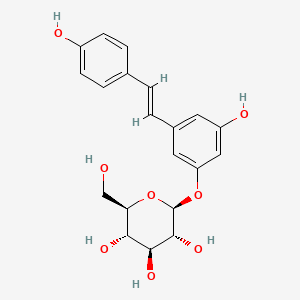Ferroptosis-centered Drug Response Information
General Information of the Drug (ID: ferrodrug0196)
| Name |
Polydatin
|
||||
|---|---|---|---|---|---|
| Synonyms |
Piceid; 27208-80-6; 65914-17-2; Trans-Piceid; 3,4,5-Trihydroxystilbene-3-beta-monoglucoside; 3,4,5-Tsg; (2S,3R,4S,5S,6R)-2-(3-Hydroxy-5-(4-hydroxystyryl)phenoxy)-6-(hydroxymethyl)tetrahydro-2H-pyran-3,4,5-triol; Resveratrol 3-beta-mono-D-glucoside; (2S,3R,4S,5S,6R)-2-[3-hydroxy-5-[(E)-2-(4-hydroxyphenyl)ethenyl]phenoxy]-6-(hydroxymethyl)oxane-3,4,5-triol; Resveratrol 3-O-beta-glucopyranoside; (E/Z)-Piceid; MLS001424114; CHEBI:8198; XM261C37CQ; (2S,3R,4S,5S,6R)-2-(3-hydroxy-5-((E)-4-hydroxystyryl)phenoxy)-6-(hydroxymethyl)tetrahydro-2H-pyran-3,4,5-triol; trans-resveratrol 3-beta-glucoside; trans-resveratrol 3-beta-D-glucoside; 3,4'-5-Trihydroxystilbene-3-beta-D-glucopyranoside; trans-resveratrol 3-O-beta-D-glucoside; 3,5,4'-Trihydroxystilbene 3-glucoside; SMR000466371; 3,4',5-trihydroxystilbene-3-beta-D-glucoside; b-D-Glucopyranoside,3-hydroxy-5-[(1E)-2-(4-hydroxyphenyl)ethenyl]phenyl; C20H22O8; Resveratrol 3-Glucoside; 5-Tsg; resveratrol 3-O-beta-D-glucoside; UNII-XM261C37CQ; MFCD00210592; E/Z-Polydatin; E/Z-Piceid; (E)-Piceid; 5-Trihydroxystilbene-3-beta-monoglucoside; 3-Hydroxy-5-(2-(4-hydroxyphenyl)ethenyl)phenyl-beta-D-glucoside; Resveratrol 3-O-glucoside; Resveratrol 5-O-glucoside; SCHEMBL41411; MLS000759499; trans-Resveratrol 3-glucoside; CHEMBL142652; Resveratrol 3-beta-D-glucoside; trans-Resveratrol 3-O-glucoside; BDBM60919; CHEBI:94610; cid_5281718; HSTZMXCBWJGKHG-CUYWLFDKSA-N; DTXSID001030555; HMS2051A20; HY-N0120; resveratrol-3-O-b-mono-D-glucoside; LMPK13090012; s2390; AKOS015961013; CCG-100895; DB11263; KS-5384; NC00145; Resveratrol 3-.beta.-mono-d-glucoside; NCGC00246971-01; NCGC00246971-04; (2S,3R,4S,5S,6R)-2-[3-hydroxy-5-[(E)-2-(4-hydroxyphenyl)vinyl]phenoxy]-6-(hydroxymethyl)tetrahydropyran-3,4,5-triol; AS-13910; trans-resveratrol 3-beta-d-glucopyranoside; CS-0007830; AB00639953-07; EN300-7416763; 3,4',5-Trihydroxystilbene-3-b-D-glucopyranoside; A818955; 5,4'-dihydroxystilbene-3-O-beta-D-glucopyranoside; Q-100342; Q3902665; RESVERATROL 3-.BETA.-MONO-D-GLUCOSIDE [MI]; W-203441; 3,4',5-TRIHYDROXYSTILBENE-3-BETA-MONOGLUCOSIDE; 3,4'-5-Trihydroxystilbene-3-beta-D-glucopyranoside, 97%; 3,4'-5-TRIHYDROXYSTILBENE-3-.BETA.-D-GLUCOPYRANOSIDE; 3-Hydroxy-5-[(1E)-2-(4-hydroxyphenyl)ethenyl]phenyl-beta-D-glucopyranoside; 3-hydroxy-5-[(E)-2-(4-hydroxyphenyl)ethenyl]phenyl beta-D-glucopyranoside; 3-Hydroxy-5-[2-(4-hydroxyphenyl)ethenyl]phenyl beta-D-glucopyranoside; b-D-Glucopyranoside, 3-hydroxy-5-[2-(4-hydroxyphenyl)ethenyl]phenyl; beta-D-Glucopyranoside, 3-hydroxy-5-(2-(4-hydroxyphenyl)ethenyl)phenyl; GLUCOPYRANOSIDE, 3-HYDROXY-5-(P-HYDROXYSTYRYL)PHENYL, .BETA.-D-; .BETA.-D-GLUCOPYRANOSIDE, 3-HYDROXY-5-((1E)-2-(4-HYDROXYPHENYL)ETHENYL)PHENYL; .BETA.-D-GLUCOPYRANOSIDE, 3-HYDROXY-5-(2-(4-HYDROXYPHENYL)ETHENYL)PHENYL; 5-((1E)-2-(4-HYDROXYPHENYL)ETHENYL)-1,3-BENZENEDIOL-3-.BETA.-MONO-D-GLUCOSIDE; beta-D-Glucopyranoside, 3-hydroxy-5-(2-(4-hydroxyphenyl)ethenyl)phenyl-, (E)-; (2R,3S,4S,5R,6S)-2-(hydroxymethyl)-6-[3-[(E)-2-(4-hydroxyphenyl)ethenyl]-5-oxidanyl-phenoxy]oxane-3,4,5-triol; (2S,3R,4S,5S,6R)-2-[3-hydroxy-5-[(E)-2-(4-hydroxyphenyl)vinyl]phenoxy]-6-methylol-tetrahydropyran-3,4,5-triol; (2S,3R,4S,5S,6R)-2-{3-hydroxy-5-[(1E)-2-(4-hydroxyphenyl)ethenyl]phenoxy}-6-(hydroxymethyl)oxane-3,4,5-triol; .beta.-D-Glucopyranoside, 3-hydroxy-5-[(1E)-2-(4-hydroxyphenyl)ethenyl]phenyl3,5,4'-Trihydroxystilbene 3-glucoside
Click to Show/Hide
|
||||
| Structure |
 |
||||
| Formula |
C20H22O8
|
||||
| IUPAC Name |
(2S,3R,4S,5S,6R)-2-[3-hydroxy-5-[(E)-2-(4-hydroxyphenyl)ethenyl]phenoxy]-6-(hydroxymethyl)oxane-3,4,5-triol
|
||||
| Canonical SMILES |
C1=CC(=CC=C1C=CC2=CC(=CC(=C2)OC3C(C(C(C(O3)CO)O)O)O)O)O
|
||||
| InChI |
InChI=1S/C20H22O8/c21-10-16-17(24)18(25)19(26)20(28-16)27-15-8-12(7-14(23)9-15)2-1-11-3-5-13(22)6-4-11/h1-9,16-26H,10H2/b2-1+/t16-,17-,18+,19-,20-/m1/s1
|
||||
| InChIKey |
HSTZMXCBWJGKHG-CUYWLFDKSA-N
|
||||
| PubChem CID | |||||
Full List of Ferroptosis Target Related to This Drug
Phospholipid hydroperoxide glutathione peroxidase (GPX4)
| In total 1 item(s) under this Target | |||||
| Experiment 1 Reporting the Ferroptosis-centered Drug Act on This Target | [1] | ||||
| Target for Ferroptosis | Suppressor | ||||
| Responsed Disease | Acute kidney failure | ICD-11: GB60 | |||
| Pathway Response | Fatty acid metabolism | hsa01212 | |||
| Ferroptosis | hsa04216 | ||||
| Cell Process | Cell ferroptosis | ||||
| In Vitro Model | HK-2 cells | Normal | Homo sapiens | CVCL_0302 | |
| In Vivo Model |
Male C57BL/6 mice (8-10 weeks of age, weight 20-25 g) were purchased from Experimental Animal Center of the Fourth Military Medical University (Xi'an, China) and bred in an experimental animal room of SPF grade. They were randomly divided into four groups: control (equivalent saline containing 1% DMSO) group (n = 5), cisplatin (20 mg/kg dissolved in saline) only group (n = 7), cisplatin + polydatin (40 mg/kg dissolved in 1% DMSO) group (n = 7), and cisplatin+ Fer-1 (5 mg/kg dissolved in 1% DMSO) group (n = 7) were administered intraperitoneally. Mice were injected with cisplatin once; PD or Fer-1 was given 1 h before and 24 h after cisplatin. Animals were ethically sacrificed by dislocating their spines at 48 h after cisplatin injection, and whole blood and kidneys were collected for further analysis.
Click to Show/Hide
|
||||
| Response regulation | In vitro and in vivo experiments indicated the prominent nephroprotective effects of polydatin against ferroptosis in cisplatin-induced acute kidney injury models, occurred at least partly through inhibiting excessive intracellular free iron accumulation and ROS production, rescuing GSH consumption, and enhancing GPx4 activity, thereby decreasing lipid peroxidation and ferroptosis sensitivity and ultimately attenuating the pathological progression of AKI. | ||||
